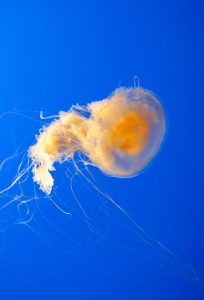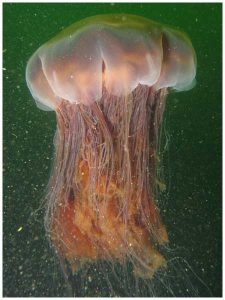Hollings scholar to study Skagit Bay’s large jellyfish during summer 2025 internship
Awarded the Ernest F. Hollings Undergraduate Scholarship for 2024-2026, a key part of this program is a summer internship with a NOAA lab. Megan Cosand’s 2025 summer internship will be studying the phenology of two large jellyfish species in Skagit Bay, which is roughly an hour’s drive north of the UW Seattle campus.
Phenology is the study of how seasonal and climate variations impact the life cycles of plants and animals, and as part of Megan’s internship, she will be looking at different environmental factors to try and figure out what contributes to blooms of different jellyfish species.
- An egg yolk jelly (Phacellophora). Credit: Tom Thai via Wikimedia Commons
- A lion’s mane jellyfish (Cyanea capillata). Credit Dan Hershman via Wikimedia Commons
Looking at egg yolk jellies and lion’s mane jellies in particular, Megan’s internship will be building on NOAA research that conducts surface trawls outside the Skagit River Estuary monthly for the past 20 or so years, collecting data on things like jellyfish species and biomass. What they have found so far is that while both species do co-occur in the same years, one or the other seems to be more likely to occur.
The bell of an egg yolk jellyfish can grow up to 2 feet in diameter, and its tentacles can grow up to 20 feet long. Lion’s mane jellyfish can grow up to 8 feet in diameter, and its tentacles can grow up to 120 feet!
Both these species of jellyfish are carnivorous predators that eat a variety of prey including other jellies, fish, and crustaceans, and because of their varied diet and the fact that jellyfish populations are increasing due to climate change, being able to predict jellyfish demographics will give scientists more information about how they affect the food chain and could be competing with forage fish that are important for salmon.
Megan will be working at NOAA’s Montlake Laboratory, which is a part of the Northwest Fisheries Science Center (NWFSC), with Dr. Correigh Greene. “Egg yolk and lion’s mane jellies are some of the most common large jellies I have seen, so I am very excited to learn more about them and build connections with people who work in and around Puget Sound!” Megan said.

